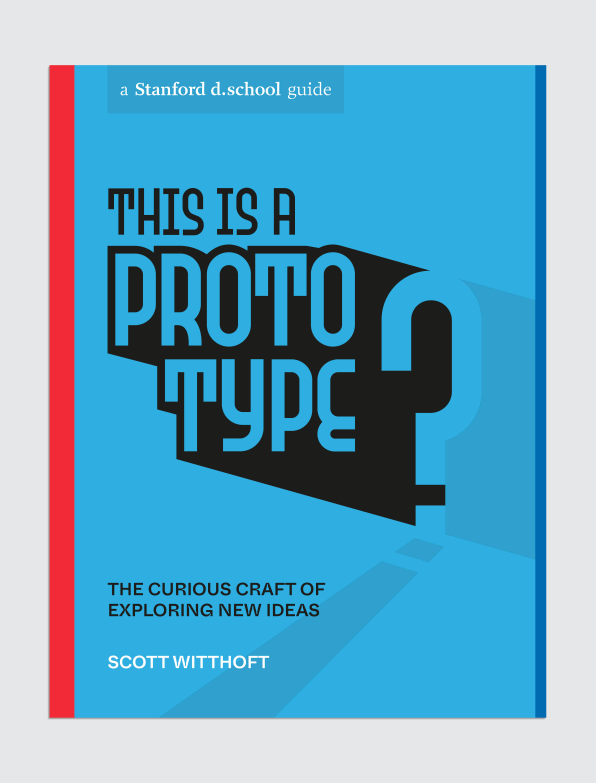How to make a design prototype
How do you close the gap between I wonder and I know? You create a prototype. A prototype is a tool that gives you a chance to examine your ideas and explore what could, should, or would come next, whether it’s designing a new product, working out a new routine, or rearranging your furniture. It’s a modest tool for the lofty goal of testing the future, or at least testing a question you have about your future. Prototyping helps lower the stakes in exploring new questions by reducing risk—by consuming fewer resources like time, money, and emotional commitment—especially when fear of the results might keep you from getting started.
Prototyping is a primary tactic for designers, but it’s a tool that’s emerging in distant realms as well. Skateboarders and chefs, for example, know that intention doesn’t have to be perfect. A skateboarder tries a new trick: This is a prototype experience. A chef experiments with a new recipe: This is a prototype experience. We know from both the skater and the chef that the next try is coming after understanding what happened the first time. This is a strategy of repetition, not a singular performance. This is also a learning strategy where discovery is embedded in every outcome. Through knowingly imperfect trials, prototype experiences illuminate possibilities for your next step.
Unlike finished products that are ready to be purchased, prototypes are inherently imperfect and impermanent. Its value lies in efficiency, which helps you learn the most from the fewest resources. This makes them a unique type of tool, so the best prototype currently doesn’t have to be “best-built” quality.
The low resolution of prototypes invites behavior where the things you make break. Make and break is how you learn through experience. This means that prototyping is inherently provocative, with an undeniable element of prolific sabotage. It is often misrepresented as a trivial act of trial and error, or recklessly moving fast for the sake of an accident. Sure, speed is a virtue, but a prototype’s job is to learn from the broken parts before unleashing fallout on the world. In a way, that means prototyping is a slow art of fiddling around; It takes practice to create prototypes that turn out well.
The parts and process of prototyping are often part of the technical vocabulary, which can be intimidating. But prototyping is an everyday practice, perfect for any moment when your curiosity meets intent. Defining your prototype and incorporating the prototype experience from the start is well placed to build the confidence to answer the big question: What am I doing?

Doing with Mindset
Develop a few mindsets to turn all your prototyping decisions into action. This is almost too quick a way to grasp the breadth of concepts you’ve considered up to this point, but it’s by no means trivial. Being comfortable with the way you do your work is an important metric for tackling the challenges you face when delving into subjects you’ve never explored or cases in that you’ve never considered prototyping as an option.
When you start doing something uncomfortable or new, details can demand more attention and distract you from focusing on your motivation. Early questions that feel like they call for immediate answers include:
Which tools should I use?
How many prototypes are enough?
How do I know when I’m done?
If you use a few mindsets to create a log, you can figure out these details or improvise them, depending on whether you think they’re important or not. Try these three mindsets to guide your practice:
1. Do not use more than necessary.
The art of the prototype builder is to make the best out of the least. The essence of the experience depends on establishing just a few details, while the rest can come from the context and creativity of the moment. Two tactics you can employ are (1) editing down to a few basic elements as part of a prototype experience and (2) refraining from over-preparing for every eventuality.
Choose your basic details based on the core question you’re asking and save the rest for later. This is a deliberate measure of restraint to make you feel comfortable when experiences deviate from what you thought was possible and what really happens when other people interfere. Have you ever planned or attended a picnic? This is an event that starts with just a few key details and works around to make it a success
surprising improvisation. If you get frustrated with details or get too specific, remember that make it a picnic— Compare the available resources with the question you hope to ask.
2. Do it wrong but do it for real.
Build prototypes that are physically and conceptually “big” as you can. They try to make the imaginable believable. Focus on fully emulating the work while limiting your time and resources. A few distilled details can make an experience feel real and immersive, just like a theatrical backdrop from a play.
The closer your prototype is to reality, the better you will be able to understand a person’s true reactions and behaviors. Consider these two scenarios as possible prototypes:
Tell me what you would do if you found $100,000.
Here’s $100. Show me how you would spend it.
The first approach can only generate guesswork as an answer, while the second can show a real result. A hundred dollars in hand is not trivial. It feels real because it’s not hypothetical, and the scale is significant.
3. Always make it an experience.
An experience offers a participant the opportunity to engage with a question or situation in a real way through sensory and emotional activity. This is a difference between creating a prototype and conducting a survey or interview. Make it a point to always ask with an experience and not just with words.
An experience offers a participant the opportunity to engage with a question or situation in a real way through sensory and emotional activity. This is a difference between creating a prototype and conducting a survey or interview. Make it a point to always ask with an experience and not just with words.
Instead of asking a recent college grad, “What’s the most important thing in your life right now?” ask with an experience: sSpend $100 on something important in your life right now. The experience can go beyond an answer like “save for the future” and focus on real details like: Where do I actually deposit my savings? or Do I spend the money on gifts for friends? Maybe spend on repairing a bike to commute to your new job? An experience will always provide useful information that a question alone cannot cover.
You’re good to go! With clear questions, goals, and mindset, you’re ready to prototype. Everything else builds on these core components.

The above story is reprinted with permission This is a prototype: the strange craft of exploring new ideas by Scott Witthoft and Stanford d.school, published by Ten Speed Press, an imprint of Penguin Random House.
Scott Witthoft works as an educator, designer and writer. With a background in forensic structural engineering, he combines this expertise with current endeavors in space, furniture and product design – teaching and speaking widely. He is co-author of the book Make space, a tool for creating collaborative environments. He has also written articles for the conference committee and Harvard Business Review. His work has been featured in the Design Museum and in publications such as Fast company, architecture and urbanismand metropolis.